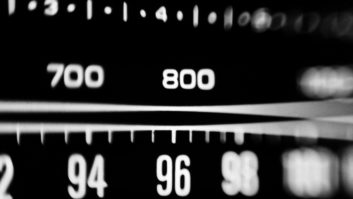When the Sound matters
Nov 1, 2005 12:00 PM, By Doug Irwin
It’s not too hard to imagine the following scenarios. 1. You are listening to the radio on your way to work, and you notice that your new format competitor sounds a little louder, brighter, dynamic and with a better stereo image. 2. Your station’s new program director tells you how his last station used processor X and how great it sounded. Then he asks what is used here. 3. Your station is about to embark on an HD Radio project, and you need processing for the digital portion.
Sounds to me like it’s time to shop for new audio processing. With that in mind, let’s look at where technology has gone over the last few years with on-air audio processing. Much of it is applicable to streaming audio processing as well.
An early start

DSP is everywhere. Omnia and Orban use a great deal of it in their flagship processors.
DSP-based audio processing first became available in the early 1990s. Not counting software revisions along the way, most companies are now shipping at least the third generation of their DSP hardware. I mention this because there are so many classic, older analog processors still on the air. The advantages to DSP-based processing are manifold, but those that seem most important to me, such as look-ahead limiting and the ability to remotely control and adjust the units via RS-232 or Ethernet, completely outweigh any prejudices I ever harbored.
Today’s DSP audio processors completely blow their old counterparts away. Even if you disagree with this idea � if you think that analog is the only way to go for a medium that is, after all, an old-fashioned analog technology � there are new products out there for you, too. Even they have digital communications interfaces, though.
Aside from the really big-ticket items, such as a transmitter, an antenna or a new console, an audio processor used to be one of the most expensive capital items that a radio station needed. Today there is a trend toward less-expensive versions of the big flagship products, which are perhaps more obtainable in a smaller market scenario. There are quite a few manufacturers as well, and the prices of audio processors have dropped over the last few years.
Down to business
Omnia’s flagship processor 6EX (or 6EXI) offers the modern features that you would expect. Its processing engine is totally DSP-based. Some of the basic features are a six-band limiter with adjustable crossover points; a built-in, DSP-based stereo generator with a composite clipper; and the now-ubiquitous Ethernet connectivity. The 6EX provides a simultaneous processing path for HD Radio; and the 6EXI option includes a diversity delay that allows the user to avoid the delay line built in to HD Radio exciters, thus completely isolating the analog transmission from the HD radio equipment.

Analog audio is alive and well in the Aphex Model 2020 MKIII.
Omnia also offers a less-expensive, DSP-based FM audio processor called the Omnia-3. Its sibling, the Omnia-3net, is specifically built for streaming audio applications. Finally, if you have delved or are about to delve into streaming audio, you may want to consider the Omnia A/X, a software-based processor that runs on a computer and works in conjunction with Windows Media, Real and MP3 streaming encoders.
Omnia offers AM processors as well, including the 5EX and the 5EX+HD. These share many of the same features with their FM brothers, such as AES inputs and outputs, DSP-based processing and Ethernet connectivity.
Orban has a new flagship product: the Optimod-FM 8500. Again, its processing functions are completely handled by DSP, including the AGC, multi-band processing, stereo encoding and composite clipping. It also has a parallel processing path for digital radio included as a standard feature, along with a built-in diversity delay. Communications with the 8500 can be performed with simple contact closures from a remote control or automation system, via RS-232 or via its TCP/IP interface, which comes standard.
The Optimod-FM 5300 is a new product that includes many of the same features as its more expensive, bigger brother the 8500. It is a DSP-based five-band processor all in one rack unit, with the same communications means standard.
Orban also offers the Optimod-PC, which is a professional sound card designed specifically for streaming media applications. On-board DSP performs the typical audio processor functionality: AGC, multi-band, EQ and look-ahead limiting. It also can function as a mixer, because it has one stereo analog input, two AES-S/PDIF inputs with sample rate converters and one .WAV input.

The software-based Omega_FM processor features a simplified control panel and user interface.
And finally, Orban offers Opticodec-PC, which is encoding software that makes use of MPEG-4 AAC/AAC Plus encoding technologies. It’s available in multiple versions and able to run on all the standard platforms.
Orban has a new AM processor as well, the Optimod-AM 9400. This is essentially two processors in one. Each section shares the input AGC and stereo enhancement, but then the two different paths � one for digital and one for analog � diverge into specific processing chains. Analog and digital ins and outs are standard, along with Ethernet connectivity.
You might want to think about getting rid of that plate-modulated transmitter while you’re at it�I know it’s an old classic, but you’re never going to see a modulator balance adjustment accomplished via TCP/IP.
If you simply will not buy the idea that DSP-based audio processing is the best thing since sliced bread, I have good news. Aphex offers the 2020 MkllI, which carries out the processing functions (leveling and multi-band AGC) strictly in the analog domain. Pre-emphasis limiting and stereo generation can be added as options, as can the digital input and output. Remote control of the device is possible via RS-232.
Look to the future
Perhaps you feel that an audio processor based on DSP chips has built-in obsolescence.
In that event you should look in to the Inovonics Omega_FM, which Inovonics states has processing power that is �largely software based.� Most of the controls are available at the front panel, but the unit can also be controlled by a PC via a serial connection. Built-in analog and digital ins and outs, and a stereo generator are standard features.
Linear Acoustic has developed a line of digital audio processors including one for FM and HD Radio: the Aeromax-HDFM. This unit includes processors for FM, the primary HD Radio service and two more auxiliary channels, along with 5.1-channel surround encoding. It includes the diversity delay (adjustable in 1ms increments) and a front-panel spectrum analyzer to view the composite output. Not surprisingly, it includes all the communications facilities that you would expect, such as built-in Ethernet connectivity.
A relative newcomer to the field of audio processing for radio is Broadcast Warehouse, which offers the DSPX. This unit has many of the same features of more expensive units from different manufacturers: DSP-based leveling, multi-band AGC, look-ahead limiting and stereo generation with composite clipping, all in one rack-unit package. Communications with the unit can be accomplished via serial or Ethernet.
IDT from France has introduced the DBP2@FM. This unit offers two bands of audio processing (with adjustable cross-overs), stereo enhancement, peak limiting and digital stereo encoder. The unit offers analog inputs and outputs, along with an AES input that will accept 32-, 44.1-, 48- or 96kHz sample rates. Communications are achieved via serial, Ethernet or good old general-purpose contacts.
Another possibility is that you only need an AGC amplifier inline ahead of a transmission path. Translantech Sound makes a couple of products just for this purpose: the Ariane and the newly introduced Ariane Sequel. The original Ariane has analog ins and outs and will work over a 30dB range. The new Sequel has analog and AES inputs and outputs, and keeps the same feature set as the original, except that all the processing is done in the digital domain. It includes serial and Ethernet communications of course.
New audio processing can be one of the best capital investments made at a radio station, AM or FM. If you find yourself in that market, take your time and look at all the available options. Form your own opinion on what sounds best on your station by testing out loaner processors available from many equipment distributors. It can be a lot of work but usually it will pay off.
Resource Guide
On air processing and processing accessories
AEV
+39 051 950 350
www.aev.net
Aphex Systems
818-767-2929
www.aphex.com
Broadcast Devices
914-737-5032
www.broadcast-devices.com
Broadcast Technology
719-336-3902
www.broadcasttech.com
Broadcast Warehouse
+44 208 5409992
www.broadcastwarehouse.com
Circuit Research Labs (CRL)
800-535-7648
www.crlsystems.com
Dixon Systems
416-261-3773
www.dixonsystems.com
Harris
800-622-0022
www.broadcast.harris.com
IDT Impact Development
+33 472 18 19 20
www.idt-fr.com
Inovonics
800-733-0552
www.inovon.com
Linear Acoustic
888-292-3117
www.linearacoustic.comMicrocon Systems
440-546-0967
www.soundgreat.com
Modulation Sciences
800-826-2603
www.modsci.com
Neural Audio
425-814-3200
www.neuralaudio.com
Nicom
619-477-6298
www.nicomusa.com
Omnia Audio
216-241-3343
www.omniaaudio.com
Orban
510-351-3500
www.orban.com
SBS
+44 1789 768870
www.sbsfm.com
Sofratec
+33-4-93019999
www.sofratec.com
TC Electronic
818-665-4900
www.tcelectronic.com
Translantech Sound
212-222-0330
www.translantech.com
Waves
865-546-6115
www.waves.com
Irwin is director of engineering for Clear Channel Radio Seattle.












